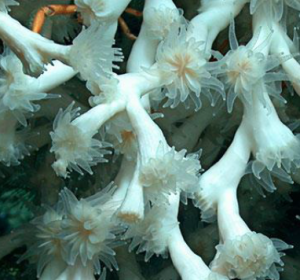
From March 10-22, 2015, a team of NOAA-led researchers will explore the benthic environment of the deep seafloor from 50-500 meters deep in the Channel Islands National Marine Sanctuary aboard NOAA ship Bell M. Shimada.
The focus of the study is patterns in deep-sea corals – patterns of change with depth and bottom type, but also change over time, in the growth of a deep-sea coral.
Using a remotely operated vehicle (ROV) from Marine Applied Research and Exploration, NOAA scientists will study the condition of deep-sea Lophelia pertusa corals in this area and monitor water chemistry in and around reefs to assess this ecosystem’s vulnerability to ocean acidification. The team will also document previously unmapped areas of the Sanctuary’s deep seafloor. The ROV is equipped with a high-definition video camera and multifunction manipulator arm to deploy data loggers and collect live corals.
The team will also collect water samples using a CTD-niskin rosette in order to measure the ‘acidification’ level of the deep seawater, which is corrosive to deep-sea corals. Southern California is the ‘future ocean’ where naturally low-aragonite saturation levels are already suppressing the abundance and distribution of deep-sea coral species. The waters are a natural laboratory for studying effects of ocean acidification that are happening here and now in the deep-sea.
Research Coordinator Chris Caldow of NOAA CINMS will lead the expedition. Dr. Peter Etnoyer of NOAA in Charleston, S.C. will lead the deep-sea coral team. Dr. Laura Kracker NOAA Silver Spring, Md., and NOAA Office of Coast Survey will lead the mapping team. Dr. Branwen Williams of Keck Science Department at Claremont Colleges will lead the studies of age and growth. The cruise will also host a Teacher at Sea as well as a VIP day on March 18 for members of the media to join the crew for a day at sea. For more information, please contact Shauna Bingham at shauna.bingham@noaa.gov.
For more information on NOAA offices contributing to this project, click here: NOAA_offices
For FAQs on the NOAA ship and science expedition, click here: Shimada_fact_sheet_3162015
For more information on the Expedition Team, click here: Expedition_Team_3162015